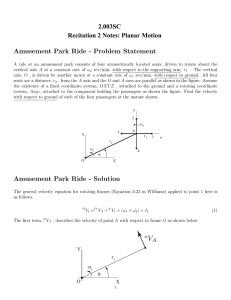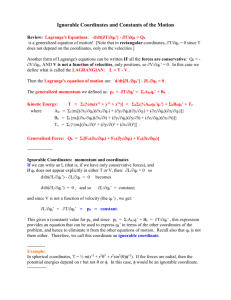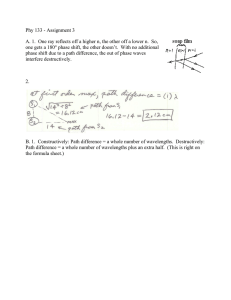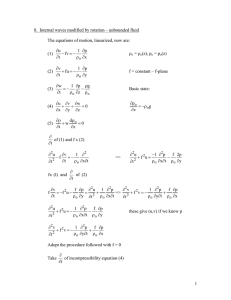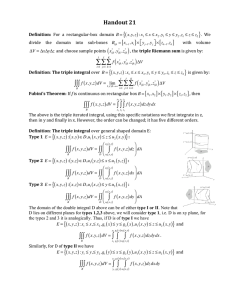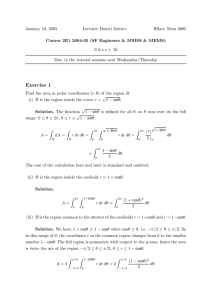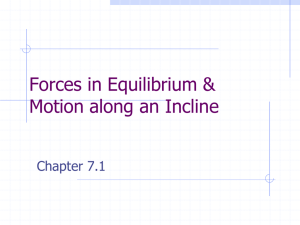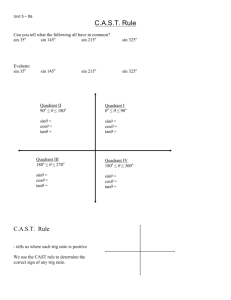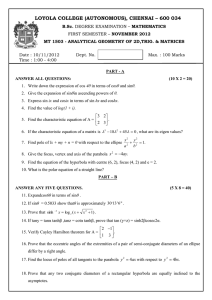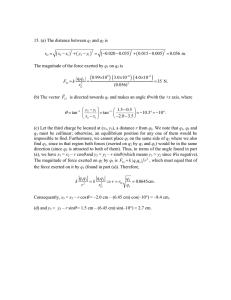EM Waveguiding
advertisement
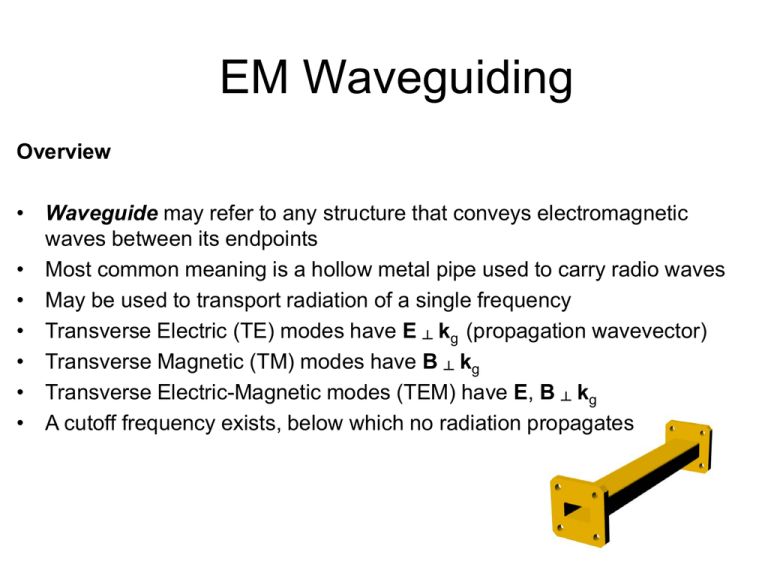
EM Waveguiding Overview • Waveguide may refer to any structure that conveys electromagnetic waves between its endpoints • Most common meaning is a hollow metal pipe used to carry radio waves • May be used to transport radiation of a single frequency • Transverse Electric (TE) modes have E ┴ kg (propagation wavevector) • Transverse Magnetic (TM) modes have B ┴ kg • Transverse Electric-Magnetic modes (TEM) have E, B ┴ kg • A cutoff frequency exists, below which no radiation propagates EM Waveguiding Electromagnetic wave reflection by perfect conductor EI EI┴ EI┴ ER┴ EI|| θi θr D┴1 = D┴2 ER┴ D┴1 = εo E ┴1 ER ER|| - - - - y - - D┴2 = εoεE ┴2 y z E||1 = E||2 z E┴ can be finite just outside conducting surface E|| vanishes just outside and inside conducting surface EI|| ER|| EI|| ER|| EI|| ER|| EoI + EoR = 0 y EoT = 0 z EM Waveguiding Electromagnetic wave propagation between conducting plates Boundary conditions B┴1 = B┴2 E||1 = E||2 (1,2 inside, outside here) E|| must vanish just outside conducting surface since E = 0 inside E┴ may be finite just outside since induced surface charges allow E = 0 inside (TM modes only) k2 B┴ = 0 at surface since B1 = 0 k1 E1 Two parallel plates, TE mode b E2 x θ b z y EM Waveguiding E = E1 + E2 Fields in vacuum = ex Eo eiωt (ei(-ky sinθ + kz cosθ) - ei(ky sinθ + kz cosθ)) = ex Eo eiωt e-ikz cosθ 2i sin( ky sinθ ) Boundary condition E||1 = E||2 = 0 means that E = E|| vanishes at y = 0, y = b E||(y=0,b) if ky sinθ = nπ k= nπ b sinθ sinθ = nπ kb n = 1, 2, 3, .. E1 = ex Eo ei(ωt - k1.r) k1 = -ey k sinθ + ez k cosθ k1.r = - ky sinθ + kz cosθ E2 = -ex Eo ei(ωt - k2.r) k2 = +ey k sinθ + ez k cosθ k2.r = + ky sinθ + kz cosθ EM Waveguiding Allowed field between guides is E = ex Eo eiωt e-ikz cosθ 2i sin( ky sinθ ) = ex Eo eiωt e-ikz cosθ 2i sin(nπy/b) Since nπ sinθ = kb n2π2 1/2 cosθ = 1 − 2 2 kb The wavenumber for the guided field is kg = k cosθ = k2− n2π2 1/2 n = 1, 2, 3, .. b2 Fields E1 = ex Eo ei(ωt - k1.r) k1 = -ey k sinθ + ez k cosθ k1.r = - ky sinθ + kz cosθ E2 = -ex Eo ei(ωt - k2.r) k2 = +ey k sinθ + ez k cosθ Ex k2.r = + ky sinθ + kz cosθ sin(nπy/b) y Profile of the first transverse electric mode (TE1) EM Waveguiding Magnetic component of the guided field from Faraday’s Law ∇ x E = -∂B/∂t = -iω B for time-harmonic fields B = i∇ x E /ω = 2 Eo / ω (0, ikg sin(nπy/b), √(k2 - kg2) cos(nπy/b) ) ei(ωt - kgz) The BC B┴1 = B┴2 = 0 is satisfied since By = 0 on the conducting plates. The E and B components of the field are perpendicular since Bx = 0. The phase velocity for the guided wave is vp = ω / kg = c k / kg kg = k2 − n2π2 1/2 n2π2 −1/2 Hence vp = c 1 − 2 2 b2 kb The group velocity for the guided wave is vg = ∂ω / ∂kg= c ∂k / ∂kg = c kg / k vp vg = c2 EM Waveguiding Frequency Dispersion and Cutoff b b θ θ’ 6 k= nπ b sinθ sinθ = nπ kb cutoff when sinθ → 1 ck cn ω = ck = 2πν ν = = 2π 2b sinθ c ω π νcutoff = or cutoff = (n = 1) c b 2b n2π2 1/2 ω2 n2π2 1/2 2 k g= k − 2 = c 2 − b2 b 5 ω c 4 n=33 2 modes n=22 n = 11 0 1 propagating mode vacuum propagation 1 2 3 4 5 kg 6 EM Waveguiding Summary of TEn modes E = 2 Eo (i sin(nπy/b), 0 ,0) kg = ei(ωt - kgz) k2 − n2π2 1/2 b2 B = 2 Eo / ω (0, ikg sin(nπy/b), √(k2 - kg2) cos(nπy/b) ) ei(ωt - kgz) Phase velocity vp = ω / kg = c k / kg E B Group velocity vg = ∂ω / ∂kg = c kg / k x x νcutoff,n = ckcutoff,n c = n 2π 2b y y n = 1 mode viewed along kg EM Waveguiding Electric components of TEn guided fields viewed along x (plan view) n=1 n=2 n=3 n=4 z y Magnetic components of TEn guided fields viewed along x (plan view) z y EM Waveguiding Rectangular waveguides Boundary conditions B┴1 = B┴2 E||1 = E||2 E|| must vanish just outside conducting surface since E = 0 inside E┴ may be finite just outside since induced surface charges allow E = 0 inside B┴ = 0 at surface a Infinite, rectangular conduit x b z y EM Waveguiding TEmn modes in rectangular waveguides TEn modes for two infinite plates are also solutions for the rectangular guide E field vanishes on xz plane plates as before, but not on the yz plane plates Charges are induced on the yz plates such that E = 0 inside the conductors Let Ex = C f(x) sin(nπy/b) ei(ωt - kgz) In free space ∇.E = 0 and Ez = 0 for a TEmn mode and ∂Ez/∂z = 0 Hence ∂Ex/∂x = -∂Ey/∂y f(x) = -nπ / b cos(mπx/a) satisfies this condition By integration Ex = -C nπ / b cos(mπx/a) sin(nπy/b) ei(ωt - kgz) Ey = C mπ / a sin(mπx/a) cos(nπy/b) ei(ωt - kgz) Ez = 0 EM Waveguiding Dispersion Relation Substitute into wave equation (∇2 - 1/c 2 ∂ 2/∂t2 )E = 0 mπ 2 nπ 2 ∇2Ex,y = − − − kg2 Ex,y a b ∂ 2/∂t2 Ex,y = - ω2 Ex,y mπ 2 nπ 2 − − − kg2 - ω2 / c 2 = 0 a b 2 kg = k2 − m2π2 n2π2 − 2 a2 b Magnetic components of the guided field from Faraday’s Law Bx = -C mπ / a kg / ω sin(mπx/a) cos(nπy/b) ei(ωt - kgz) By = -C nπ / b kg / ω cos(mπx/a) sin(nπy/b) ei(ωt - kgz) Bz = i C (k2 −kg2) / ω cos(mπx/a) cos(nπy/b) ei(ωt - kgz) EM Waveguiding Cutoff Frequency 2 kg = k2 − m2π2 n2π2 − 2 a2 b ckcutoff c m2π2 n2π2 1/2 m2 n2 1/2 νcutoff = = + 2 =c + b 4a2 4b2 2π 2π a2 EM Waveguiding Electric components of TEmn guided fields viewed along kg m=0n=1 m=1n=1 m=2n=2 m=3n=1 x y Magnetic components of TEmn guided fields viewed along kg x y EM Waveguiding Comparison of fields in TE and TM modes www.opamp-electronics.com/tutorials/waveguides_2_14_08.htm EM Waveguiding The TE01 mode Most commonly used since a single frequency νcutoff,02 > ν > νcutoff,01 can be selected so that only one mode propagates. Example 3 cm radar waves in a 1cm x 2 cm guide 1/2 12 02 νcutoff,01= c + 4a2 4x4.10−4 1/2 12 02 νcutoff,01= c + 4x1.10−4 4x4.10−4 = 7.5 x 109 Hz = 7.50 x 109 Hz 1/2 02 12 νcutoff,10= c + 4x1.10−4 4x4.10−4 = 1.50 x 1010 Hz 1/2 12 12 νcutoff,11= c + 4x1.10−4 4x4.10−4 = 1.68 x 1010 Hz
